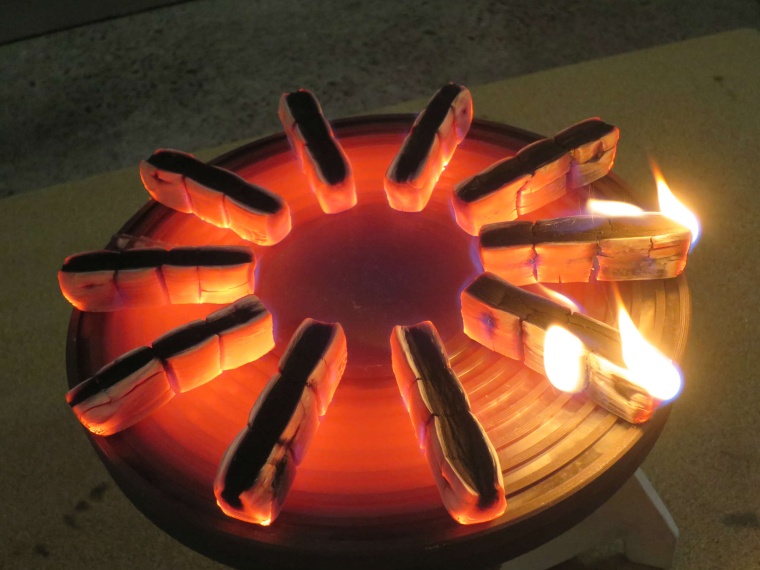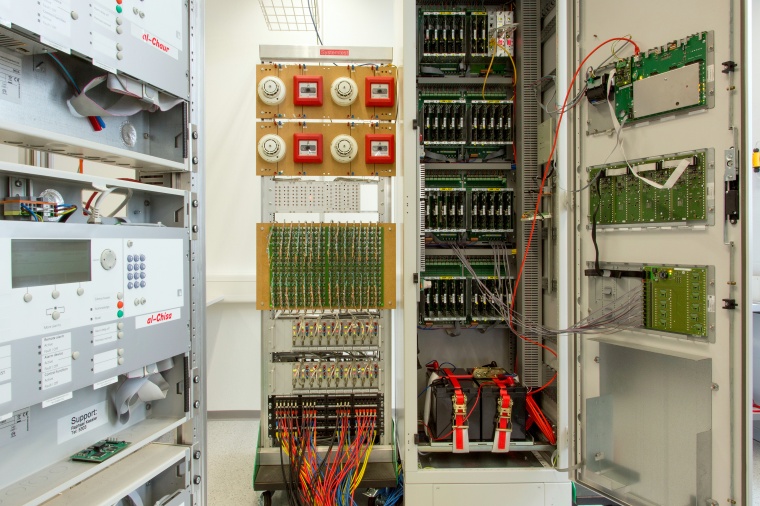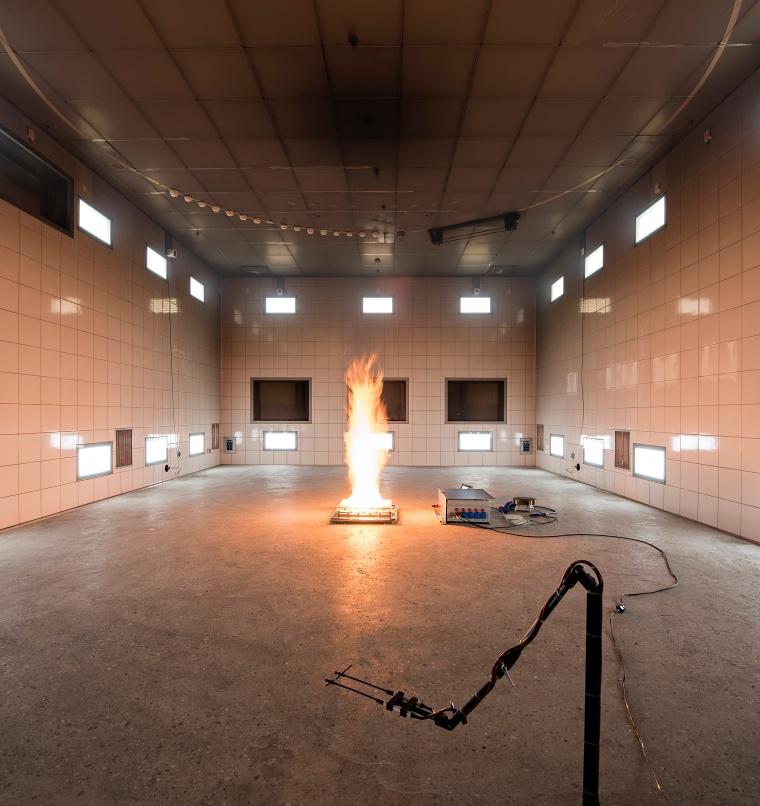Siemens Fire Lab Supports the Product Development of Fire Protection Products
During a Fire Safety Press Event at the Siemens BT headquarters in Zug, Switzerland, journalists from Europe did get an impression how state-of-the-art fire safety is based on exte...



During a Fire Safety Press Event at the Siemens BT headquarters in Zug, Switzerland, journalists from Europe did get an impression how state-of-the-art fire safety is based on extensive knowledge of safety requirements and innovative solutions. A visit of the test labs plus business presentations demonstrated Siemens’ competence in fire safety.
Red Hot: The 500 m³ Fire Room
To develop cutting-edge fire safety products, you need to understand how fire works. To supply sophisticated, reliable and deception-proof fire detectors, BT has used a variety of fire rooms in Zug over the past decades. Because of new construction on the HQ campus, a new fire lab was placed in operation at the beginning of this year. Fire tests are conducted in a large and a small fire room under various ambient conditions in order to study the behavior of different fires and to rigorously test BT fire safety products. The core of the laboratory cluster is undoubtedly the large fire room, which boasts 500 cubic meters of usable space. But that‘s not all. Clustered around this fire room are a number of highly specialized laboratories where research related to individual fire criteria such as smoke, heat, gas and optics is performed. Other facilities, such as the MegaFoot lab for testing large, networked systems, complement the physical labs. The entire facility makes daily contributions to advancing BT‘s sophisticated fire safety products, systems and solutions.
The core of the laboratory cluster is the large fire room, a massive concrete space of impressive exterior dimensions: 12 meters long, 8 meters wide and 8 meters high, it offers 500 m3 of usable capacity. Its white-tiled walls are more reminiscent of an operating room, and it has very specific requirements. Filtered air is piped in and out, for example, so fire tests can be conducted under uniform ambient conditions. With the door closed, and depending on how the ventilation dampers are set, the room is completely sealed. “When we test a smoldering fire in the center of the room, we must be able to measure it reproducibly within a three-meter circle on the ceiling,“ explains Urs Schmid, the fire lab director. “Different surface temperatures would cause undesired airflows in the fire room. That is why the walls, floor and ceiling are controlled for differences of less than 0.1 °C. Embedded water lines totaling over 2,300 meters in length ensure a uniform temperature. Heat, smoke particles, combustion gases and flames should spread reproducibly without disruptive airflows in the room, and especially at the ceiling, to allow reliable and differentiated measurement of individual phenomena. “Reproducible physical combustion phenomena are essential for the development of a fire detector’s design and sensors,” explains Schmid.
Manifold Reasons For Fire Tests
Tests must be fast-paced to keep up with the high demand. A completely new detector naturally requires multiple rounds of testing during its development. Even a new detection algorithm, a new sensor element or a different type of plastic for the optics chamber must be thoroughly tested. A change in supplier requires extensive testing as well. Building Technologies not only conducts qualification tests of new detectors in the fire lab, changes to existing detectors are also reviewed.
Siemens tests its new fire detectors in the large fire room according to the specifications defined in the applicable standards. A variety of materials – wood, plastics, liquids, textiles, cables and paper – are burned or smoldered in a number of different processes. These tests help with the development of the products, their design as well as the algorithms that detect and report a fire or differentiate deceptive phenomena. Not only does Siemens need to precisely detect hazards such as gas, heat, smoke and flames as early as possible over a certain period of time, but also accurately differentiate them in total and in combination as well as calculate them intelligently.
Testing Beyond the Standards
“The requirements defined in the standards are not sufficient for us,” underscores Urs Schmid, “because we assume full responsibility for the quality and functionality of the products we make and sell. A standard does not assume any responsibility.” Therefore, the large fire room is augmented by a smaller test room where fire tests can be carried out at starting temperatures from -30 °C to +70 °C. Only with such extreme tests, which are not required by any standard, can Siemens ensure that its detectors will function reliably and as expected at all times.
Moreover, the fire detectors are subjected to extremely rigorous types of tests. In addition to the usual long-term climate stress tests at high temperature and humidity, mechanical tests are also performed. A vibration test that shakes the detector over all three axes for a longer period of time, for example, examines how it responds and if it is able to consistently maintain proper functionality. Additionally, more severe vibration tests are conducted on detectors to be used in aircraft or on ships. Impact and shock resistance are tested in a pneumatic machine as well as using a sledgehammer.
Other highly specialized laboratories like the optics laboratory, the gas lab and the smoke and aerosol lab, each focused on an individual fire characteristic, augment the two fire rooms.
Realism is Key: The MegaFoot Test Lab
The MegaFoot lab was established to meet the requirements of major customers. It is used to test the behavior of large, networked installations of up to 64 fire control panels, such as those used in universities, hospitals or large company campuses. These systems centrally monitor and manage fire safety in many different buildings, which are often quite far apart. The installation allows the configuration of different network topologies with up to 40,000 simulated fire detectors. This makes it possible to test the communication between the fire control panels and the management stations. Right now, for example, the MegaFoot lab is configured to test the fire safety system of a power plant, and in three weeks the same facility will simulate the security system of the metro in a large city.
“We conduct several thousand tests in our fire lab every year,” explains Urs Schmid. “Many of them are specified by the numerous standards. We repeat some tests several times because the various standards (EN, UL, GB, etc.) require different test conditions. However, we do run additional tests of our own to allow us to take full responsibility for our products, as I mentioned earlier.” The focus is not only on different flammable materials and detector types but also on realism. Will a fire detector be used in a tunnel, a data center or a kitchen where the chef is preparing a flambé? These scenarios produce completely different physical signals that can be reliably reproduced and verified only in real-world tests that comply with the standards. “Nothing comes closer to reality than our fire laboratories,” says Schmid. “And there is no better proof than our detectors, which function as expected – robustly, reliably and immune to deceptive phenomena – day after day all over the world.”
Test to Develop the Best
“We make the world a safer place” is the approach of the Siemens Fire Safety business line as Johannes Mario Kahlert, Head Fire Safety, explained during his presentation. Siemens BT offers a holistic perspective across products, solutions and verticals and aims to deliver a complete fire safety offering from a single source. Leonhard Füsser explained that the enormous expense for the product testing leads to a huge advantage for the customers: Siemens gives a guarantee against false alarms. False alarms are a big risk to life safety due to desensitized tenants, employees and customers to the danger of a real fire. False alarms mean disruption and standstill in business administration and production due to staff evacuation, they lead to annoyed customers and possible future charging for attendance by fire and rescue services.
Another direct result of the R&D work in the test labs was presented by Leonhard Füsser, Global PLM Head Fire Safety: Siemens Silent Extinguishing Technology for Hard Disk Drives (HDDs) was developed in Zug, where many tests with different configurations proved that inert gas extinguishing systems with <110 dB at the location of the cabinet are safe for the HDD in server rooms. Several years ago the fire protection industry became aware of potential disruptions to magnetic hard disk drives and storage systems during the discharge of gas extinguishing systems. With the unique Sinorix Silent Extinguishing Technology, Siemens is now offering safe and quiet extinguishing for data centers and server rooms. The heart of the technology is the Sinorix Silent Nozzle which can prevent noise-induced disruptions to hard disk drives and entire storage systems in data centers and server rooms. The tests leading to the product were performed in a reference room which shows realistic and comparable characteristics to a data center.
Business Partner
Siemens Smart InfrastructureTheilerstrasse 1a
6300 Zug
Switzerland
most read

Assa Abloy's battery-powered Aperio KL100 secures lockers
Boost workplace security and operational flexibility by securing more than just doors.

GIT SECURITY AWARD 2026 - The winners have been announced!
GIT SECURITY AWARD 2026: The best safety and security solutions of the year - now an overview of all winners


The Benefits of AI-based Video Surveillance Solutions for Sports Venues
Dallmeier Interview: Artificial intelligence Makes Stadiums Smarter

Airbus Defence and Space: Security as a strategic pillar of Europe's defense capability
Airbus Defence and Space protects sites, technologies and employees with modern security and cyber solutions - strengthening Europe's resilience in uncertain times








